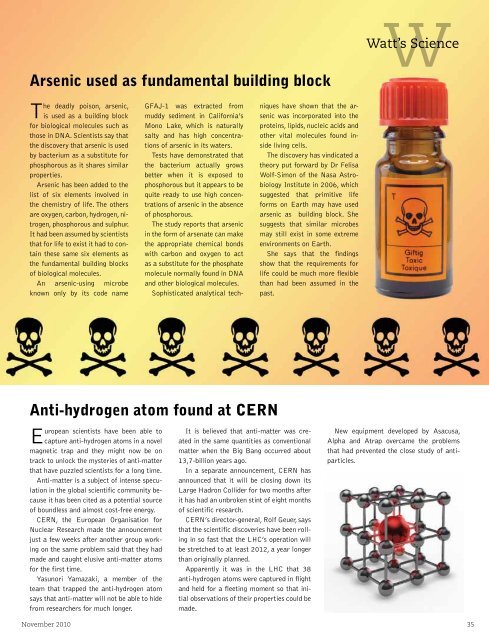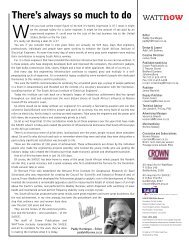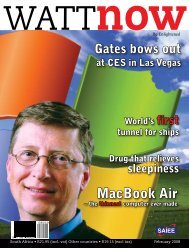download a PDF of the full November 2010 issue - Wattnow
download a PDF of the full November 2010 issue - Wattnow
download a PDF of the full November 2010 issue - Wattnow
Create successful ePaper yourself
Turn your PDF publications into a flip-book with our unique Google optimized e-Paper software.
Arsenic used as fundamental building block<br />
The deadly poison, arsenic,<br />
is used as a building block<br />
for biological molecules such as<br />
those in DNA. Scientists say that<br />
<strong>the</strong> discovery that arsenic is used<br />
by bacterium as a substitute for<br />
phosphorous as it shares similar<br />
properties.<br />
Arsenic has been added to <strong>the</strong><br />
list <strong>of</strong> six elements involved in<br />
<strong>the</strong> chemistry <strong>of</strong> life. The o<strong>the</strong>rs<br />
are oxygen, carbon, hydrogen, nitrogen,<br />
phosphorous and sulphur.<br />
It had been assumed by scientists<br />
that for life to exist it had to contain<br />
<strong>the</strong>se same six elements as<br />
<strong>the</strong> fundamental building blocks<br />
<strong>of</strong> biological molecules.<br />
An arsenic-using microbe<br />
known only by its code name<br />
GFAJ-1 was extracted from<br />
muddy sediment in California’s<br />
Mono Lake, which is naturally<br />
salty and has high concentrations<br />
<strong>of</strong> arsenic in its waters.<br />
Tests have demonstrated that<br />
<strong>the</strong> bacterium actually grows<br />
better when it is exposed to<br />
phosphorous but it appears to be<br />
quite ready to use high concentrations<br />
<strong>of</strong> arsenic in <strong>the</strong> absence<br />
<strong>of</strong> phosphorous.<br />
The study reports that arsenic<br />
in <strong>the</strong> form <strong>of</strong> arsenate can make<br />
<strong>the</strong> appropriate chemical bonds<br />
with carbon and oxygen to act<br />
as a substitute for <strong>the</strong> phosphate<br />
molecule normally found in DNA<br />
and o<strong>the</strong>r biological molecules.<br />
Sophisticated analytical techniques<br />
have shown that <strong>the</strong> arsenic<br />
was incorporated into <strong>the</strong><br />
proteins, lipids, nucleic acids and<br />
o<strong>the</strong>r vital molecules found inside<br />
living cells.<br />
The discovery has vindicated a<br />
<strong>the</strong>ory put forward by Dr Felisa<br />
Wolf-Simon <strong>of</strong> <strong>the</strong> Nasa Astrobiology<br />
Institute in 2006, which<br />
suggested that primitive life<br />
forms on Earth may have used<br />
arsenic as building block. She<br />
suggests that similar microbes<br />
may still exist in some extreme<br />
environments on Earth.<br />
She says that <strong>the</strong> findings<br />
show that <strong>the</strong> requirements for<br />
life could be much more flexible<br />
than had been assumed in <strong>the</strong><br />
past.<br />
W<br />
Watt’s Science<br />
Anti-hydrogen atom found at CERN<br />
European scientists have been able to<br />
capture anti-hydrogen atoms in a novel<br />
magnetic trap and <strong>the</strong>y might now be on<br />
track to unlock <strong>the</strong> mysteries <strong>of</strong> anti-matter<br />
that have puzzled scientists for a long time.<br />
Anti-matter is a subject <strong>of</strong> intense speculation<br />
in <strong>the</strong> global scientific community because<br />
it has been cited as a potential source<br />
<strong>of</strong> boundless and almost cost-free energy.<br />
CERN, <strong>the</strong> European Organisation for<br />
Nuclear Research made <strong>the</strong> announcement<br />
just a few weeks after ano<strong>the</strong>r group working<br />
on <strong>the</strong> same problem said that <strong>the</strong>y had<br />
made and caught elusive anti-matter atoms<br />
for <strong>the</strong> first time.<br />
Yasunori Yamazaki, a member <strong>of</strong> <strong>the</strong><br />
team that trapped <strong>the</strong> anti-hydrogen atom<br />
says that anti-matter will not be able to hide<br />
from researchers for much longer.<br />
It is believed that anti-matter was created<br />
in <strong>the</strong> same quantities as conventional<br />
matter when <strong>the</strong> Big Bang occurred about<br />
13,7-billion years ago.<br />
In a separate announcement, CERN has<br />
announced that it will be closing down its<br />
Large Hadron Collider for two months after<br />
it has had an unbroken stint <strong>of</strong> eight months<br />
<strong>of</strong> scientific research.<br />
CERN’s director-general, Rolf Geuer, says<br />
that <strong>the</strong> scientific discoveries have been rolling<br />
in so fast that <strong>the</strong> LHC’s operation will<br />
be stretched to at least 2012, a year longer<br />
than originally planned.<br />
Apparently it was in <strong>the</strong> LHC that 38<br />
anti-hydrogen atoms were captured in flight<br />
and held for a fleeting moment so that initial<br />
observations <strong>of</strong> <strong>the</strong>ir properties could be<br />
made.<br />
New equipment developed by Asacusa,<br />
Alpha and Atrap overcame <strong>the</strong> problems<br />
that had prevented <strong>the</strong> close study <strong>of</strong> antiparticles.<br />
<strong>November</strong> <strong>2010</strong> 35

















